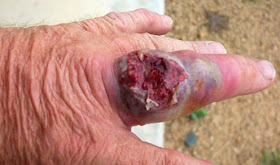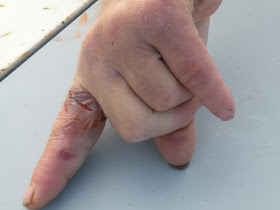From 1953 to 1973 excavations were carried out on the large Old Slavic burial place beside the parish church in Kranj, Slovenia. The archeological site opened
in 1981, and is placed at the north end of the Gothic parish Church of St.
Cantius, Cantianus, Cantianilla, and Protus in Kranj. In an underground area the excavated material can be viewed
in chronological order, with photographs and illustrations. Also visible
are the masonry foundations of a baptistry or memorial together with
the semicircular base of the wall of a round ossuary dating from the
late 13th century. Also on view are the remains of a cemetery chapel
with a 15th-century tomb that belonged to the Counts Eghk, the owners off Brdo Castle near Kranj, plus a more recent ossuary that contains carefully-stacked layers of skulls and bones of the deceased.
Wednesday, February 29, 2012
Cupping Therapy
Wet cupping or ‘Hijama’, which comes from the Arabic word for ‘sucking’,
took on particular importance in the Arab world, after words of the Prophet
Muhammed. Wet cupping has been credited in the Islamic faith as a cure for various
ailments such as headaches, stomach problems, poisoning and alleviating
pain. Hijama supposedly will help to remove impurities and stimulate bone marrow to produce new blood and increase circulation. Hijama is a combination of cupping and blood-letting. Cupping is widely
used to treat pain and muscular aches, indigestion, colds, fever and
even arthritis. Whilst blood-letting is credited with removing toxins, excess iron and excess red blood cells from the body.
The skin is first shaved, to ensure a tight seal with
the cup. The mouth of a cup (metal, glass and plastic cups are generally
used, although traditionally horns were used) is placed on the skin and a tight seal is created. The
traditional method was to burn a small piece of paper or cotton inside
the vessel, so that the mouth of the cup clings to the skin. Modern
practitioners now use a machine instead, although others strictly adhere
to the classic method with the use of fire, both for sterility and
the benefits or properties from the element of fire itself. The cup is
left to cling to the skin for a few minutes, then it is lifted off and a
couple of small incisions are made in the skin. The cup is then
put back as it was before until the flow of blood subsides Cupping usually leaves round bruises on the treated area which will fade within a few days.
Monday, February 27, 2012
Cryotherapy
Appearance and healing process of a cryotherapy patient. before and after removal of the lesions. Redness, swelling, and the
formation of a blister at the site of cryotherapy are all expected
results of the treatment.
Sunday, February 26, 2012
Pet Charnel Houses in Japan
In Japan, dogs today live an average of 11.9 years, in the 1960's when dog food was first introduced they lived up to three years. A pet owner whose pet has died can have the cremation done at their
homes with a Buddhist priest at the funeral ceremony and
have the ashes placed in a charnel house. Some pets
are given funerals like those given people, where the deceased is placed
on a futon and family gather around for an all-night wake. Afterwards
an altar with the pet’s picture is set up.
Though burying your pet in a pet cemetery is available, cremation is optimal. The ashes can then be picked up and taken home, or you can pay for a 'plot', which resembles a cubby hole in the pet memorial charnel house. These charnel houses charge yearly for space and give you enough room to store your pets ashes along with a photo and often something that belonged to the pet such as a toy, or their collar and leash.
 |
 |
Saturday, February 25, 2012
Snake Bites
Snake envenomation causes pain and swelling at the bite
site and up the affected limb. Patients who have the most complications
are the ones who come to the hospital several days after being bitten. The
swelling in the limb begins to cut off the blood supply to the tissues
and can lead to death of the tissues. Surgery in these patients is
difficult until the blood begins clotting again.



























































